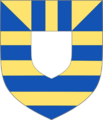Roger Mortimer, 1st Baron Mortimer of Wigmore facts for kids
Quick facts for kids
Roger Mortimer
|
|
|---|---|
| Baron Mortimer of Wigmore | |

Arms of Mortimer: Barry or and azure, on a chief of the first two pallets between two base esquires of the second over all an inescutcheon argent
|
|
| Born | c.1231 |
| Died | 27 October 1282 Kingsland, Herefordshire |
| Buried | Wigmore Abbey |
| Noble family | Mortimer |
| Spouse(s) | Maud de Braose |
| Issue | Ralph Mortimer Edmund Mortimer, 2nd Baron Mortimer of Wigmore Isabella Mortimer, lady of Clun and Oswestry Margaret Mortimer Roger Mortimer, 1st Baron Mortimer of Chirk William Mortimer |
| Father | Ralph de Mortimer |
| Mother | Gwladys Ddu |
Roger Mortimer, the First Baron Mortimer of Wigmore (born around 1231 – died October 27, 1282), was an important English noble. He lived at Wigmore Castle in Herefordshire. Roger was a marcher lord, which meant he controlled lands along the border between England and Wales. He was a loyal friend to King Henry III of England. Sometimes, he was also an enemy, and sometimes a friend, to Llywelyn ap Gruffudd, who was the Prince of Wales.
Contents
Early Life and Conflicts
Roger Mortimer was born in 1231. His father was Ralph de Mortimer. His mother was Gwladys Ddu, a Welsh princess. She was the daughter of Llywelyn ab Iorwerth, a powerful Welsh prince, and Joan Plantagenet. Joan was the daughter of King John of England. This means Roger had both English and Welsh royal blood!
In 1256, Roger started a war with Llywelyn ap Gruffudd. This happened when Llywelyn took over Roger's land in Gwrtheyrnion (also known as Rhayader). This conflict between Roger and Llywelyn continued on and off for many years. It only ended when both of them died in 1282. Interestingly, both Roger and Llywelyn were grandsons of the famous Welsh prince, Llywelyn ab Iorwerth.
Fighting for the King
Roger Mortimer was a strong supporter of King Henry III. He fought against a powerful rebel leader named Simon de Montfort, 6th Earl of Leicester. In 1264, Roger almost died fighting Montfort's soldiers at the Battle of Lewes.
A year later, in 1265, Roger's wife, Maud de Braose, played a brave part. She helped rescue Prince Edward, who would later become King Edward I. After this, Roger and Prince Edward formed an alliance. They decided to work together against Simon de Montfort.
Victory at Evesham
In August 1265, a major battle took place. Simon de Montfort's army was trapped near the River Avon. Prince Edward's army was on one side, and the river was on the other three sides. Roger Mortimer had sent his soldiers to block the only escape route, which was the Bengeworth bridge.
The Battle of Evesham began with a loud storm. Montfort's Welsh soldiers tried to escape across the bridge. But Roger's men were waiting there. They stopped the Welsh soldiers. During the battle, Roger Mortimer himself killed two important enemies: Hugh Despencer and Simon de Montfort. Roger's actions helped crush Montfort's army, leading to a big victory for the King.
Welsh Wars and Death
Roger Mortimer started building a new castle called Cefnllys Castle. This made Prince Llywelyn very upset. This disagreement was one of the reasons for King Edward I's war in Wales in 1282.
During this war, Roger Mortimer was put in charge of the fighting in mid-Wales. However, King Edward's plans suffered a big setback. Roger Mortimer died in October 1282.
Family Life
Roger Mortimer married Maud de Braose in 1247. Maud also came from a powerful family in the Welsh Marches, just like Roger. They had seven children together:
- Ralph Mortimer, who died in 1274.
- Edmund Mortimer, 2nd Baron Mortimer (1251–1304), who became his father's heir. He married Margaret de Fiennes. They had children, including Roger Mortimer, 1st Earl of March.
- Isabella Mortimer, who died in 1292. She married John Fitzalan and later Robert de Hastang.
- Margaret Mortimer, who died in 1297. She married Robert de Vere, 6th Earl of Oxford.
- Roger Mortimer, 1st Baron Mortimer of Chirk, who died in 1326.
- Geoffrey Mortimer, who died in 1273.
- William Mortimer (born around 1259 – died before June 1297). He was a hostage for his father in 1264. He became a knight but died without children.
Roger and Maud's oldest son, Ralph, died when he was young. So, their second son, Edmund, was called back from Oxford University to become his father's heir.
Roger Mortimer's Legacy
Roger Mortimer passed away on October 27, 1282, in Kingsland, Herefordshire. He was buried at Wigmore Abbey. His tombstone had a special message carved on it. It said that Roger was a great and pure leader. It also said that while he was alive, all of Wales feared his power. It claimed that Wales was given to him as a gift and remained his. The message ended by saying that Wales knew his military campaigns and that he brought it under his control.
Images for kids


